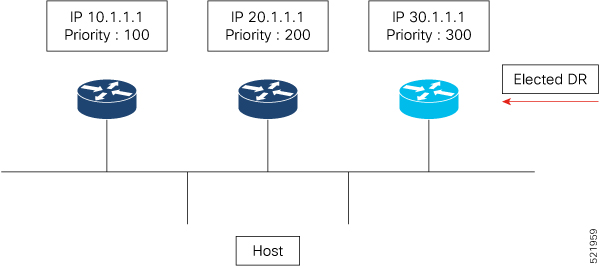Implementing Layer-3 Multicast Routing
Multicast routing allows a host to send packets to a subset of all hosts as a group transmission rather than to a single host, as in unicast transmission, or to all hosts, as in broadcast transmission. The subset of hosts is known as group members and are identified by a single multicast group address that falls under the IP Class D address range from 224.0.0.0 through 239.255.255.255.
The multicast environment consists of senders and receivers. Any host, regardless of whether it is a member of a group, can send to a group. However, only the members of a group receive the message.
-
IGMP—IGMP is used between hosts on a LAN and the routers on that LAN to track the multicast groups of which hosts are members.
-
PIM SM—Protocol Independent Multicast in sparse mode (PIM-SM) is used between routers to track which multicast packets to forward to each other and to their directly connected LANs.
-
PIM SSM— Protocol Independent Multicast in Source-Specific Multicast (PIM-SSM) has the ability to report interest in receiving packets from specific source addresses (or from all but the specific source addresses), to an IP multicast address.
-
Auto RP— Automates the distribution of RP information in a multicast network
-
Static RP— Ability to statically configure an RP for a multicast group range.
-
PIM BSR—PIM boots trap router (BSR) provides a fault-tolerant, automated RP discovery and distribution mechanism that simplifies the Auto-RP process.
Prerequisites for Implementing Multicast Routing on NCS 5000 Series Router
- You must install and activate the multicast RPM package.
-
You must be familiar with IPv4 multicast routing configuration tasks and concepts.
-
Unicast routing must be operational.
Enabling Multicast
Configuration Example
Enables multicast routing and forwarding on all new and existing interfaces.
Router#config
Router(config)#multicast-routing
Router(config-mcast)#address-family ipv4
Router(config-mcast-default-ipv4)#interface all enable
*/In the above command, you can also indicate a specific interface (For example, interface TenGigE0/0/0/3)
for enabling multicast only on that interface/*
Router(config-mcast-default-ipv4)#commitRunning Configuration
Router#show running multicast routing
multicast-routing
address-family ipv4
interface all enable
!Verification
Verify that the Interfaces are enabled for multicast.
Router#show mfib interface
Interface : FINT0/RP0/CPU0 (Enabled)
SW Mcast pkts in : 0, SW Mcast pkts out : 0
TTL Threshold : 0
Ref Count : 2
Interface : TenGigE0/0/0/1 (Enabled)
SW Mcast pkts in : 0, SW Mcast pkts out : 0
TTL Threshold : 0
Ref Count : 7
Interface : TenGigE0/0/0/3 (Enabled)
SW Mcast pkts in : 0, SW Mcast pkts out : 2
TTL Threshold : 0
Ref Count : 8







 Feedback
Feedback